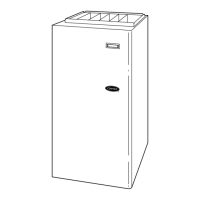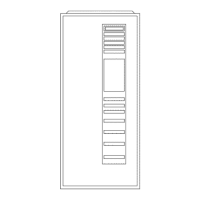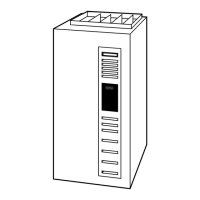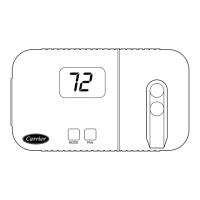8
a
27 28
4. Reinstall burner enclosure front.
5. If your furnace is free of the above conditions, replace
access door and turn on electrical and gas supplies to
the furnace. (See Fig. 13, 14, and 15.)
6. Start the furnace and observe its operation. Watch the
burner flames to see if they are clear blue, almost trans-
parent. (See Fig. 29.) If you observe a suspected mal-
function, or the burner flames are not clear blue, call
your dealer.
29
HEADING SOUTH FOR THE WINTER?
DON’T FORGET YOUR FURNACE!
Since the furnace uses a condensing heat exchanger, some
water will accumulate in the unit as a result of the heat trans-
fer process. Therefore, once it has been operated, it cannot
be turned off and left off for an extended period of time when
temperatures will reach 32
°
F or lower unless winterized. Fol-
low these procedures to winterize your furnace:
1. Obtain propylene glycol (RV/swimming pool anti-
freeze or equivalent).
DANGER
If holes are found in the pipes or if any portion has
become disconnected, toxic fumes can escape
into your home. DO NOT OPERATE YOUR FUR-
NACE. Call your dealer for service.
CAUTION
If the furnace is installed in an unconditioned
space where the ambient temperatures may be
32
°
F or lower, freeze protection measures must be
taken.
!
!
30 31
2. Turn off electrical supply to the furnace. (See Fig. 17.)
3. Remove furnace access door. (See Fig. 19.)
4. Remove upper inducer housing drain connection cap.
(See Fig. 30.)
5. Connect field-supplied 1/2-in. ID tube to upper inducer
housing drain connection.
6. Insert field-supplied funnel into tube.
7. Pour 1 quart of antifreeze into funnel/tube. Antifreeze
should run through inducer housing, overfill conden-
sate trap, and flow into open field drain. (See Fig. 31.)
8. Remove funnel and tube from inducer housing and
replace drain connection cap and clamp.
9. Replace furnace access door. (See Fig. 26.)
A CHECKUP CHECKLIST
Your furnace represents an important investment in your
family’s comfort and your home’s value. To keep it per-
forming properly and as a preventative to future problems,
have a trained service specialist give your furnace a profes-
sional check-up annually. The following checklist can be
used as a guideline to proper service:
• Inspect all flue gas passages, burners, heat exchangers,
coupling box(es), and inducer assembly.
• Inspect all combustion-air and vent piping inside structure
and pipe terminations outside the structure.
• Check gas pipes leading to and inside of your furnace for
leaks.
• Inspect and clean the blower motor and wheel.
NOTE: The inducer and blower motors are pre-lubricated
and require no additional lubrication. These motors can be
identified by the absence of oil ports on each end of the
motor.
• Inspect and change or clean air filter(s) if necessary.
• Inspect all supply- and return-air ducts for obstructions, air
leaks, and insulation. Remedy any problem when necessary.
CAUTION
Do not use ethylene glycol (Prestone II antifreeze
coolant or equivalent). Failure of plastic compo-
nents will occur.
!

